JOIN THE DAINTREE WEEDBUSTERS!

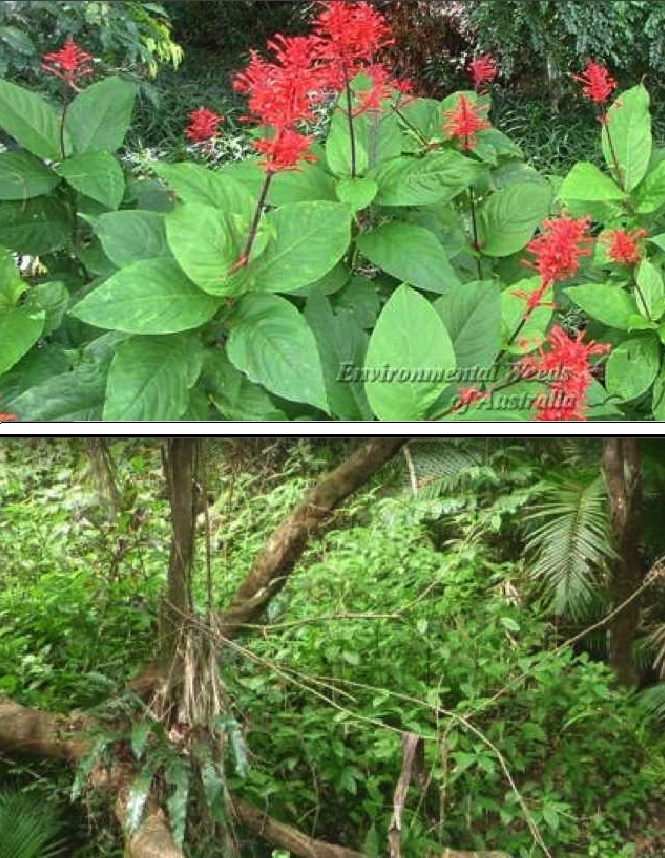

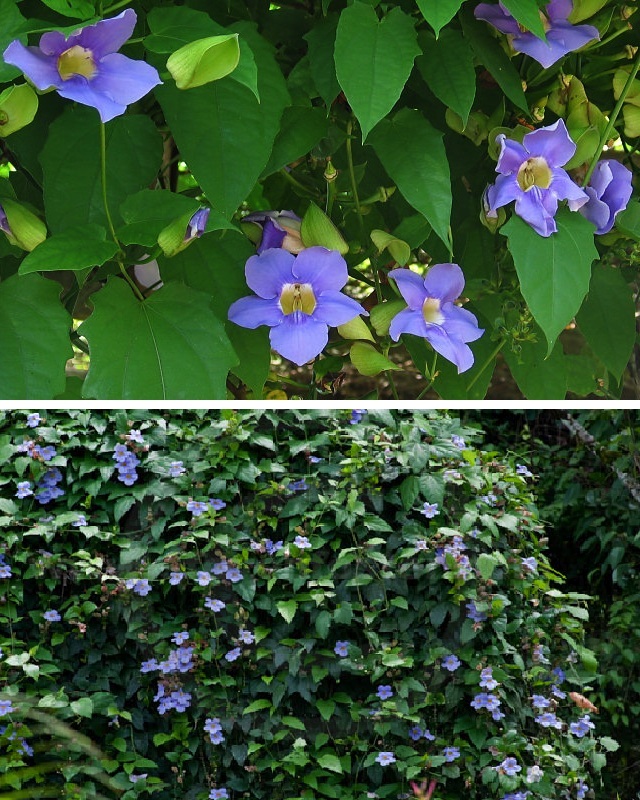
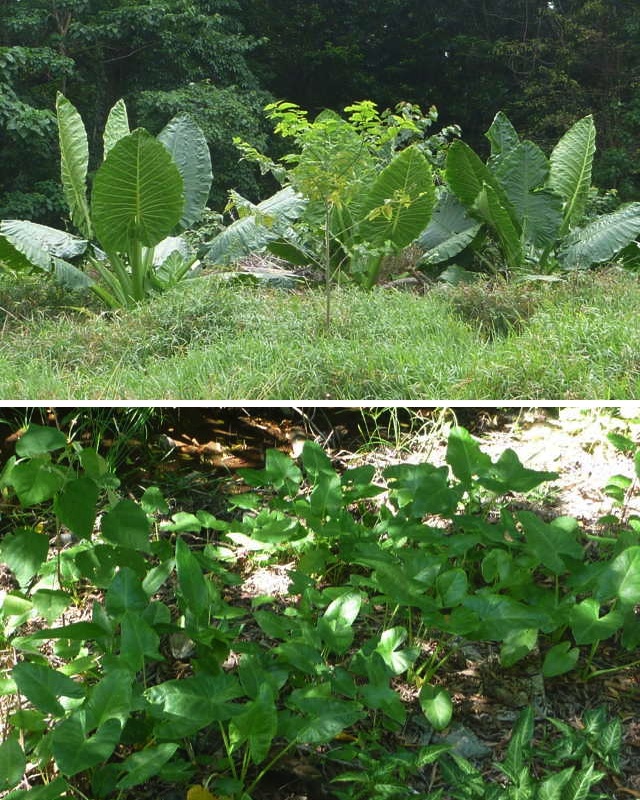

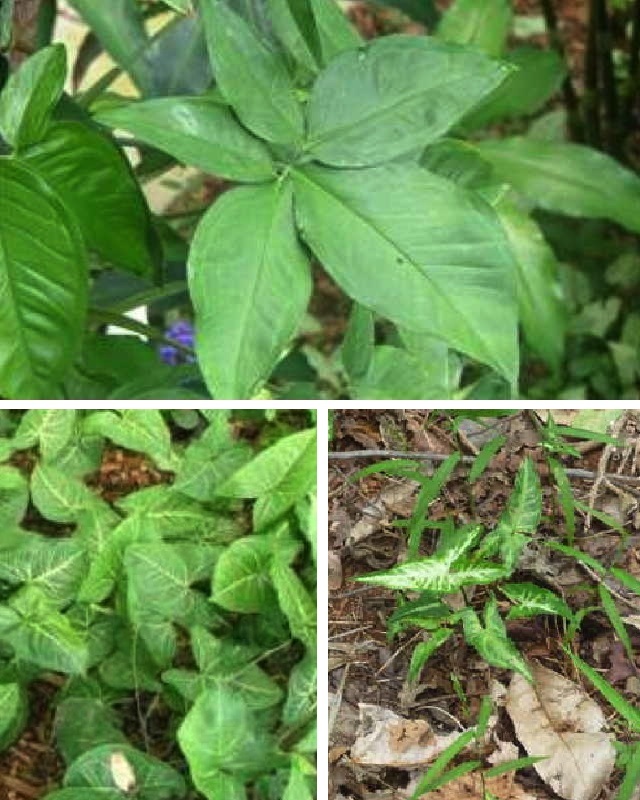

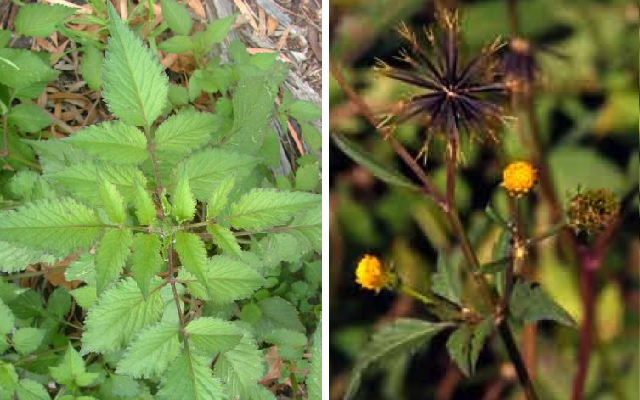
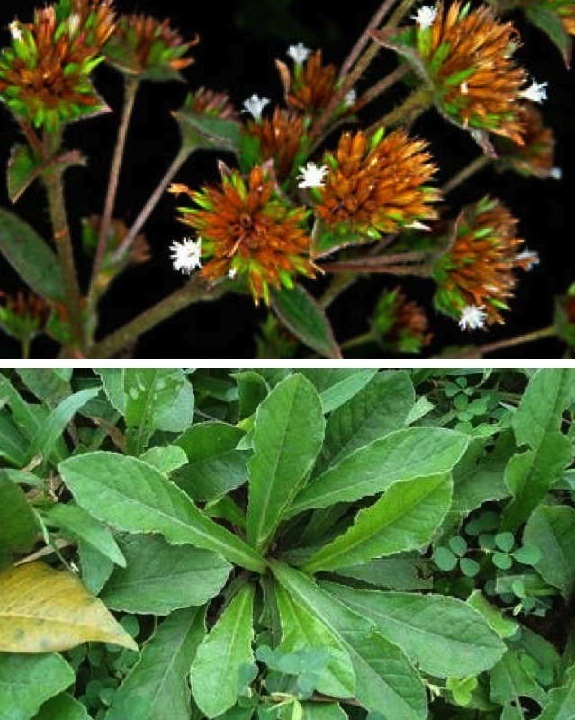



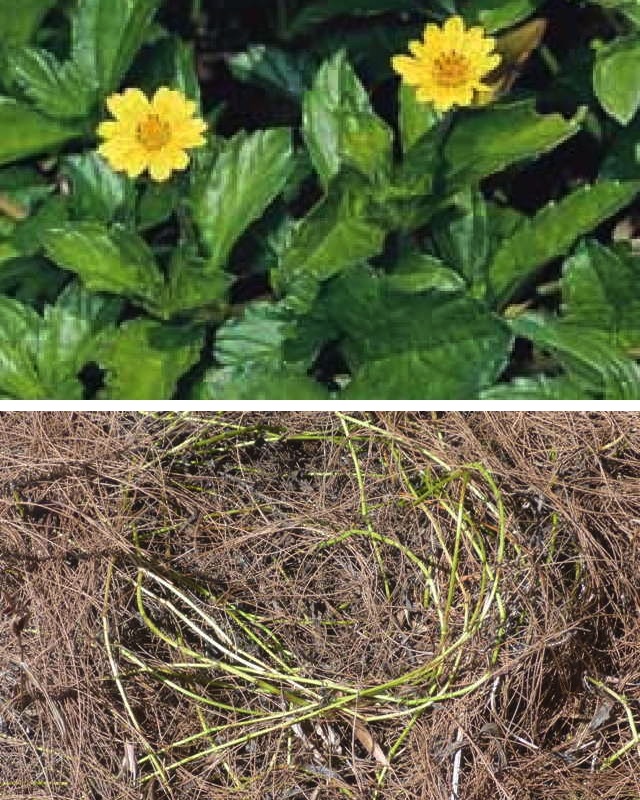
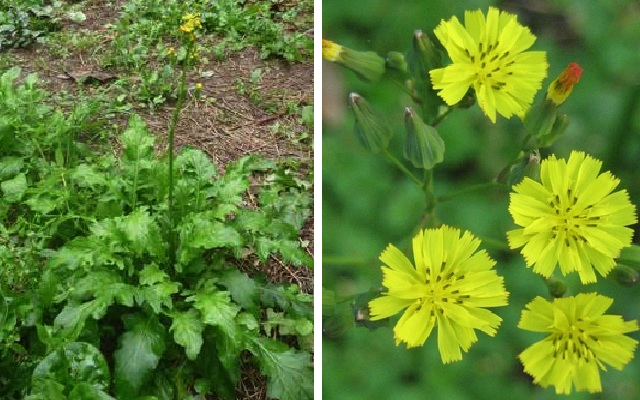
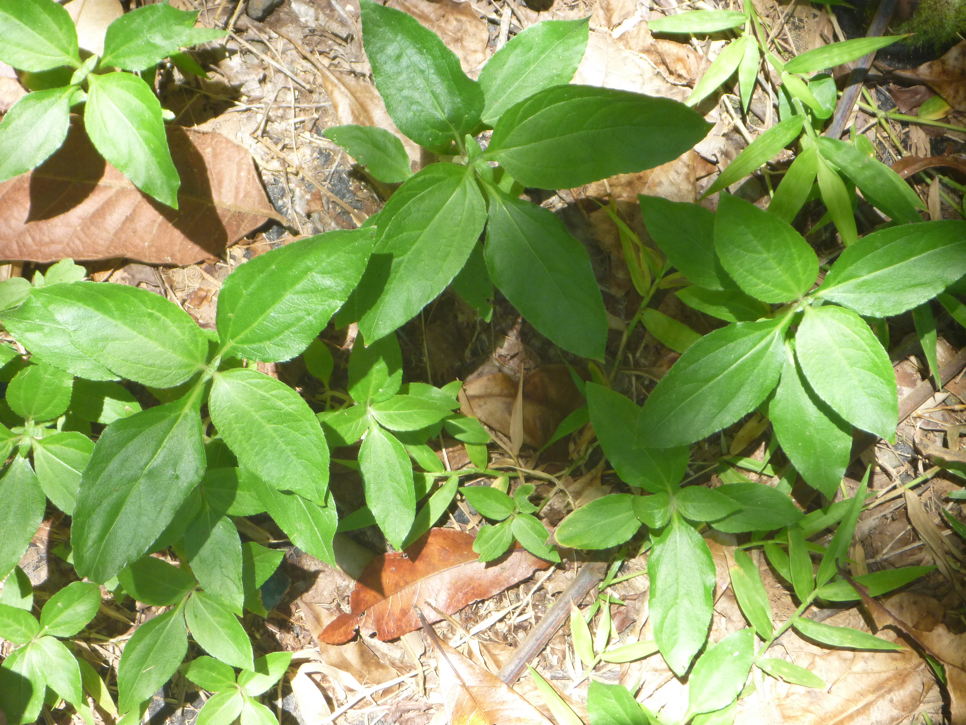



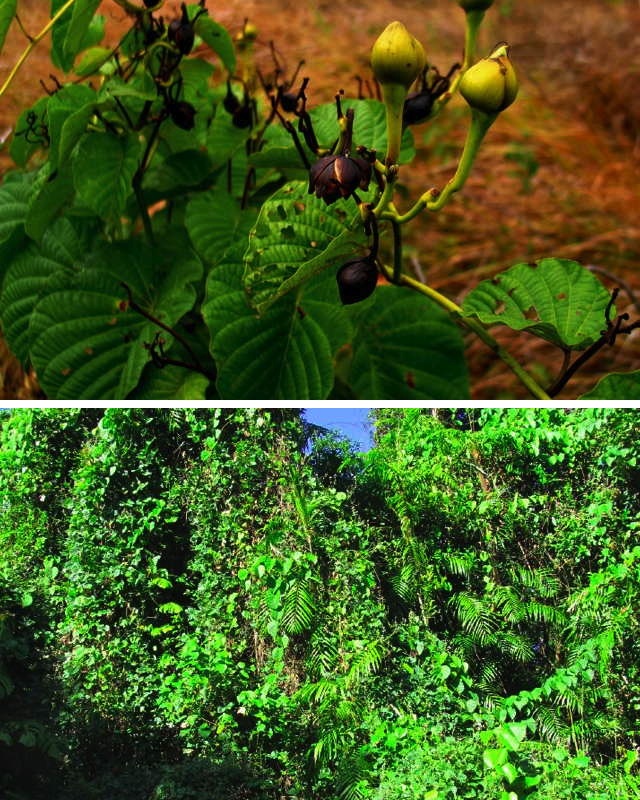


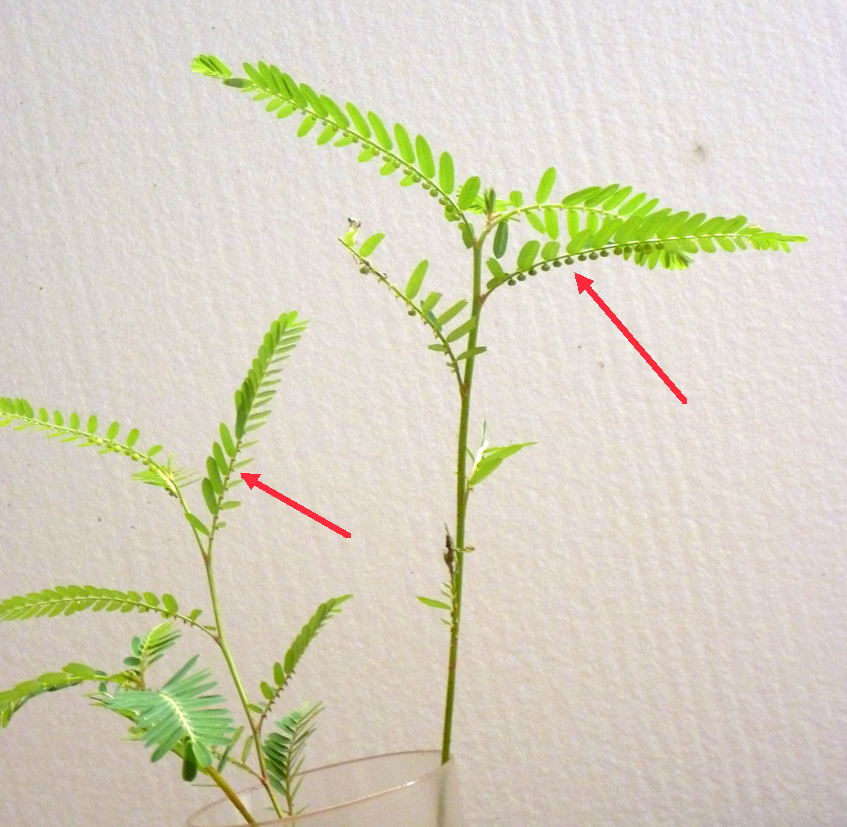

























Brilliantaisia lamium, family: Acanthaceae
A small plant but one which can reproduce very quickly! Has beautiful blue flowers followed by seed pods. Hand pull, or use MSM
Control: Class 2 MSM
Odontonema tubaeforme (Red Spike), family: Acanthaceae
Infestation of this weed is now a common sight in the Daintree. A Brazilian import related to the widely-planted Sanchezia. Red Spike is shade tolerant and will spread rapidly.
Control: Class 2 MSM
Sanchezia spp (Yellow Candles), family: Acanthaceae
This South American garden weed was introduced especially for its big variegated leaves.
Control: MSM. Note: Do NOT chop it up as every bit sprouts!
Thunbergia grandiflora (Blue Sky Vine), family: Acanthaceae
The blue sky vine has large blue flowers and distinctive ‘choko-like’ leaves. It can produce enormous underground tubers, which make control very difficult. The seeds are dispersed by “exploding”seed pods, and the resultant plants smother native vegetation.
Control: Class 2 MSM (spray the leaves) or imazapyr (Unimaz) for juvenile plants. Contact the Douglas Shire Council Weed Control for help.
DSC document
Colocasia gigantea (Giant Elephant’s Ear), family: Araceae
Native to southeastern Asia and the Indian subcontinent, these perennial plants can have leaves that are large to very large, 20 - 150 cm (7.9 - 59.1 in) long, with a sagittate shape (upper image). Juvenile Elephant’s ear with Arrow Vine near a drainage line (lower image)."
Control: MSM, remove from waterways
Dieffenbachia (Dumb Cane), family: Araceae
DO NOT get the juice in your mouth or on sensitive skin. And DO NOT let children play with the stems. The common name, "dumb cane" refers to the effect of raphides (fine needles of calcium oxalate), which can cause a temporary inability to speak.
Control: MSM or pull roots, bag and burn
Syngonium podophyllum (Arrow / Hippie Vine), family: Araceae
This vine from Central America is arguably our most worrying invasive of the rainforests north of the Daintree as it is dispersed by birds and can establish in undisturbed forest. There are two known varieties in the area; one with shovel- shaped juvenile leaves, the other with arrowhead-shaped juvenile leaves. It develops quite an extensive network of underground stems which means that it can smoulder for years and pop up again. Adult-shaped leaf form (top), shovel-shaped juvenile leaf form (bottom left), and arrow shaped juvenile leaf form (bottom right)."
Control: "MSM, pull roots, bag and burn. The shovel-shaped juvenile leaf variety is highly sensitive to MSM, and the arrow head version less so, but with persistence it can be controlled.
Ageratum conyzoides (Billygoat Weed), family: Asteraceae
These plants look a bit like Praxelis but are hairy and aromatic like this one.
Control: MSM or pull them – as they are quite shallow-rooted.
Bidens pilosa (Cobbler's Pegs), family: Asteraceae
A very new weed to the area and very common "down south". Don't let it establish here! It is shallow-rooted with very distinctive leaves and white or yellow flowers. It produces masses of long black seeds with hooked spines (“cobbler’s pegs”) that stick to fabric and animal fur.
Control: MSM or pull plants. DO NOT let it flower!
Elephantopus mollis (Tobacco Weed), family: Asteraceae
A worrying new entry to the Daintree that is native to the tropical Americas. It has cobbler's peg-like seeds that stick in clothing, and plants can grow to meter high before seeding. This agricultural weed is vigorous and aggressive in many wet tropical and subtropical countries. It smothers pasture land with its seedlings and is a major threat to north Queensland's beef and dairy industries.
Control: Class 2 MSM, or pull plants, which are shallow-rooted
Eleutheranthera ruderalis, family: Asteraceae
A common crowding weed of gardens. shallow-rooted, and easy to pull out. A single plant can spread over many square meters. MSM-sensitive
Control: MSM, pull plant
Praxelis clematidea, family: Asteraceae
A common crowding weed of roadsides, distinctive toothed leaves and purpleish flowers. DO NOT allow to flower as it produces masses of fine wind-dispersed seeds.
Control:MSM or pulling in small infestations.
Pseudelephantopus spicatus (False Elephant Weed), family: Asteraceae
DO NOT let it flower! An introduced species originally from tropical America and has "cobbler's peg" – like seeds. This weed has fibrous roots and is VERY difficult to poison.
Control: Pull seedling roots and/or use a digging fork to loosen roots. If you must, treat area with glyphosate but expect collateral damage.
Sphagneticola trilobata (Singapore Daisy), family: Asteraceae
Introduced as a ground cover, this weed is becoming the "scourge of the north" The plant can spread by as much as a meter a week in good weather and soil fertility conditions.
Control:MSM. Hand pulling only works where there are new infestations or in sandy soil. Take care not to leave bits behind in the soil. DO NOT use glyphosate (Roundup)! The lower image illustrates what happens if you do. The herbicide kills competing native grass and although the daisy drops its leaves, the stems remain green and viable. Consequently, the native grass will be destroyed (removing the competition!) but the daisy will recover. DO NOT mow. Although this plant produces very few seeds it sprouts from stem nodes which are spread by mowing. Environmental weed control may be required by local Council.
Youngia japonica (Japanese Hawkweed), family: Asteraceae
A relatively new weed to the area which is only to happy to fill the space left when other garden weeds are eliminated.
Control: MSM. DO NOT let it flower as it produces masses of fine, wind-dispersed seeds!
Synedrella nodifolia. Cinderella weed, family: Asteraceae
Common fast growing, wiry, and deep-rooted weed of roadsides and gardens. Tiny yellow flowers in leaf axils.
Control: Pull, or use MSM.
Spathodea campanulata (African Tulip Tree), family: Bignoniaceae
An introduced ornamental tree it is very invasive and its seeds are dispersed by the wind. It also spreads from root suckers. In Cairns there has been a partial extermination campaign.
Control: Class 3 MSM kills juveniles. For mature plants, "drill and fill" stems with 10% glyphosate (may work) or ringbark (best).
Senna obtusifolia (Sickle Pod), family: Caesalpinaceae
The presence of this weed usually indicates that horses have spent time on the property. Leaves have a very distinctive and unpleasant smell.
Control: Class 2 MSM, pull roots and burn. Do not allow to seed; seeds can last up to 30 years.
Ipomea indica (Blue Morning Glory), family: Convolvulaceae
Introduced from Europe. Very active climber, which has very distinctive soft white flexible stems that are easy to recognize.
Control: MSM, pull stems which are shallow-rooted.
DSC document
Merremia peltata (Captain Cook's Vine), family: Convolvulaceae
Probably one of the worst native weeds is Captain Cook's Vine or Merremia peltata. This is the native big-leafed member of the morning glory family. It is found smothering trees along the roadside or where man-made (or cyclone) damage has allowed it to grow unmolested. In an intact forest it is a natural component of the vegetation. It also will run long runners into buildings. The lower image shows trees covered with Captain Cook's Vine. The vine stops tree growth and can ultimately kill the trees.
Control: Cut stems at base and apply 10% glyphosate to lower cut stems. The stems are blotchy-dark in colour, are very soft and flexible, and exude a white sap when cut
Tetracera nordtiana (Fire Vine), family: Dilleniaceae
Related to the red beech, Dillenia alata tree (with big yellow flowers) that grows on the dunes, the native Fire Vine runs rampant in exposed areas, and can be a major invasive – especially of revegetation. Its leaves have serrated edges and stems are very tough, pale and stripey in appearance. Leaves and young stems are sandpapery to the touch and will cause a burning sensation.
Control: Cut stems and apply 10% glyphosate at the base of the plant.
Euphorbia heterophylla, family: Euphorbiaceae
A small weed version of the Poinsettia, but with no red leaves.
Control: MSM or pull up.
Phyllanthus sp., family Phyllanthaceae
A new invasive, looks like sensitive plant but the leaves don't collapse and it has no thorns. It appears to be allelopathic (stops other plants from germinating).
Control - no chemical control yet - but pull as soon as you see them.
Heliconia psittacorum (Heliconia), family: Heliconiaceae
Introduced as a commercial cut flower, this plant thrives in wet ground. It is pollinated and dispersed in Costa Rica by hummingbirds, here by sunbirds.
Control: Cut stems at base and apply 10% glyphosate.
Hyptis suavolens (Horehound), Family Lamiaceae (mints)
Has a quite strong, somewhat minty smell. This is a recent invasive here.
Control: Use MSM or pull the plant. It produces lots of seeds – if you let it.
Hyptis capitata (Knob / Pepper Pot Weed), Family Lamiaceae (mints)
Control: MSM. Cut the tops off or bag to contain the seeds, then pull the main root out of the ground. Seed heads are full of tiny black seeds that are easy to shake out.
Sida rhombifolia (Common Sida), family: Malvaceae
A member of the hibiscus family, this is a perennial or sometimes annual plant and is native to the New World tropics and subtropics. Other common names include rhombus-leaved sida, Paddy's Lucerne, jelly leaf, Cuban jute, Queensland hemp, and Indian hemp (although S. rhombifolia is not related to either jute or hemp).
Control: MSM and pull roots, especially seedlings.
Urena lobata (Urena Burr, pink burr), family: Malvaceae
Related to hibiscus. A similar-looking, but unrelated burr is the Triumfetta rhomboidea which has yellow flowers.
Control: MSM or pull roots, bag and burn especially if there are ripe (brown) burrs.
Tristemma mauritianum, family: Melastomaceae
Related to the native lassiandra (Melastoma affine) this is a new roadside weed which is dispersed by birds. DO NOT confuse it with the native shrub Melastoma (native lassiandra). Unlike Melastoma which has big purple flowers, as seen in this image, Tristemma has red leaf petioles and a small whitish flower. Tristemma also usually never gets larger than about 250mm high and is fleshy.
Control: MSM or pull roots.
Mimosa pudica (Sensitive Plant), family: Mimosaceae
A prickly rampant weed (from S america) , which has been in the Daintree area for over 100 years.
Control: MSM, pull as soon as the pink-purple flowers appear. Use good gardening gloves as some of the plants are quite big. When pulling, grab it where it emerges from the ground.
Centrosema molle (Centro), family: Papillionaceae
First introduced as a nitrogenising legume, it has become a major climbing weed for disturbed areas. The purple pea flowers make it easy to spot. The seeds are long-lasting.
Control: MSM, pull roots and be sure not to leave any nodes.
Pueraria phaseloides (Tropical Kudzu), family: Papillionaceae
Closely related to true Kudzu, "the weed that ate the South" (USA). This plant can completely overtake disturbed land.
Control: MSM, pull roots (it's fairly shallow-rooted).
Peperomia sp (Pepper Elder), family: Piperaceae
Control: MSM, or pull and bag plant.
Mitracarpus hirtus, family: Rubiaceae
Introduced from South America, this common crowding weed is found in gardens and on roadsides.
Control: MSM.
Solanum torvum (Devil’s Thorn, Devils fig), family: Solanaceae
These bird-dispersed weeds can get to the size of large shrubs and have sharp thorns.
Control: Cut stem, chop, bag and burn. Treat cut stems with 10% glyphosate.
Clerodendrum paniculatum (Pagoda Plant), family: Lamiaceae
Also known as "hanuman kireetam", this very pretty weed is native to tropical Asia and Papuasia.
Control: Cut stem and apply 10% glyphosate to the lower end.
Stachytarphetta spp (multiple species) (Snake Weed / Purple Top), family: Verbenaceae
Control: Cut stems, pull roots and treat with MSM. Bag to avoid dropped
Lantana camara, family: Verebenaceae
Serious weed further south and in the Tablelands, but here, seems to be out-competed...
Control: Class 3 MSM, pull roots (usually shallow rooted here).
Zingiber spectabile (Torch Ginger), family: Zingiberaceae
Also known as Ginger Flower, Red Ginger Lily, Torch Lily, Wild Ginger. The flower buds, and especially the ripe seed pods, are packed with small black seeds. The pink flowers are used in decorative arrangements and various parts of the flower are an important ingredient in a variety of Asian dishes.
Control: MSM or cut stems and treat bottom section with 10% glyphosate.
Costus speciosus (Costus), family: Costaceae
Has a distinctive curved growth pattern and is bird-dispersed.
Control: MSM or pull out plants and seedlings. In big infestations cut and poison with glyphosate - treat bottom section
Brachiaria spp (multiple species) Possibly now called Urochloa (Para Grass), family: Poaceae
An allelopathic plant, this weed stops the germination of other species' seeds. Where you see fields of a monoculture of low grass, it’s Brachiaria. There are patches in Cape Tribulation dating from the 1970s which still have no native revegetation.
Control: Flatten and treat area with glyphosate. DO NOT mow or burn. It makes wonderful mulch!
Panicum maximum (Guinea Grass, now Megathyrsus maximus), family: Poaceae
Also known as Green Panic grass, this weed is a large perennial bunch grass that is native to Africa, Palestine, and Yemen. It has been introduced in the tropics around the world.
Control: Pull, flatten, and treat area with glyphosate (75 mL / 15 litre water). DO NOT mow!
Cyperus aromaticus (Navua Sedge), family: Cyperaceae
Introduced from Africa, this weed has become a major invasive grass-like plant.
Control: Pull, flatten and treat area with glyphosate. Note that large infestations are exceedingly difficult to control and can require several episodes of spraying to achieve control. 'wicking' with 10% glyphosate can be used where it grows on lawns. A new herbicide, Sempra (also Kempra) – is relatively specific for sedges, however, it seems to require warm weather to be effective.
Selaginella willdenovii (Electric / Peacock Fern), family: Selaginellaceae
This invasive vine can create large infestations. Don't confuse it with the native Selaginella, which is green.
Control: Pull and bag the plants and treat any broken stems with 10% glyphosate.
Nephrolepis (Fishbone Fern), family: Lomariopsidaceae
There are a number of native species of this fern as well as many introduced from Asia. However, only the introduced species snap if you try to bend the stem.
Control: MSM
Oplismenus (Native Grass)
Native grass recovering in a highly degraded site.
Oplismenus (Native Grass)
What the native grass site looked like before recovery when covered with Arrow Vine.
Sickle Pod, Urena Burr, and Singapore Daisy
Massive growth of Sickle Pod, Urena Burr and Singapore Daisy. This area is going to require a major intervention before they flower; seeds of Sickle Pod can last 30 years.